2025届高三英语二轮复习 强调句课件(共16张)
文档属性
| 名称 | 2025届高三英语二轮复习 强调句课件(共16张) | 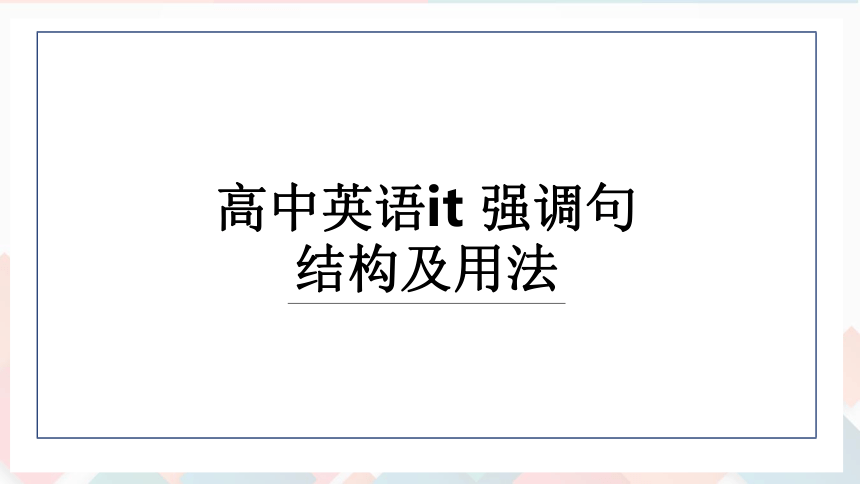 | |
| 格式 | pptx | ||
| 文件大小 | 1.4MB | ||
| 资源类型 | 教案 | ||
| 版本资源 | 人教版(2019) | ||
| 科目 | 英语 | ||
| 更新时间 | 2024-11-30 15:50:17 | ||
图片预览

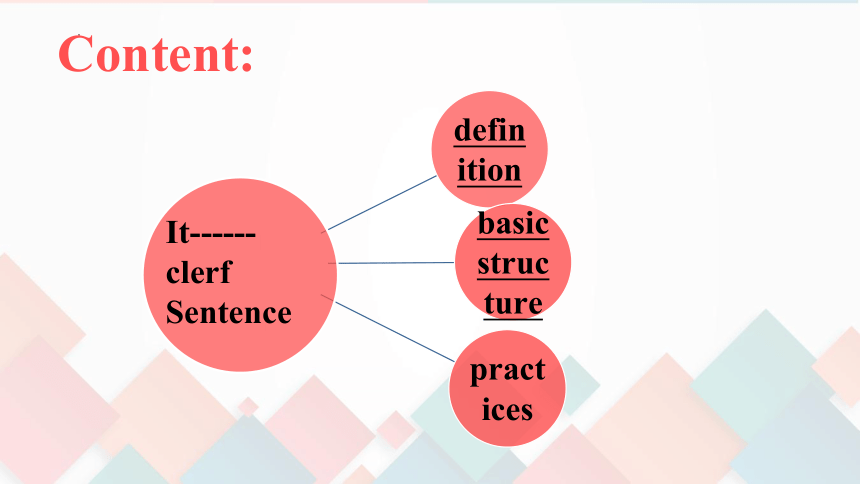
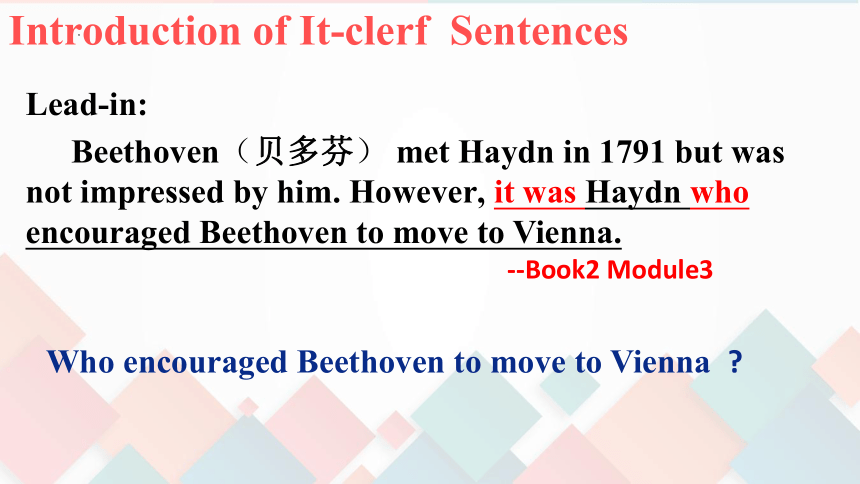

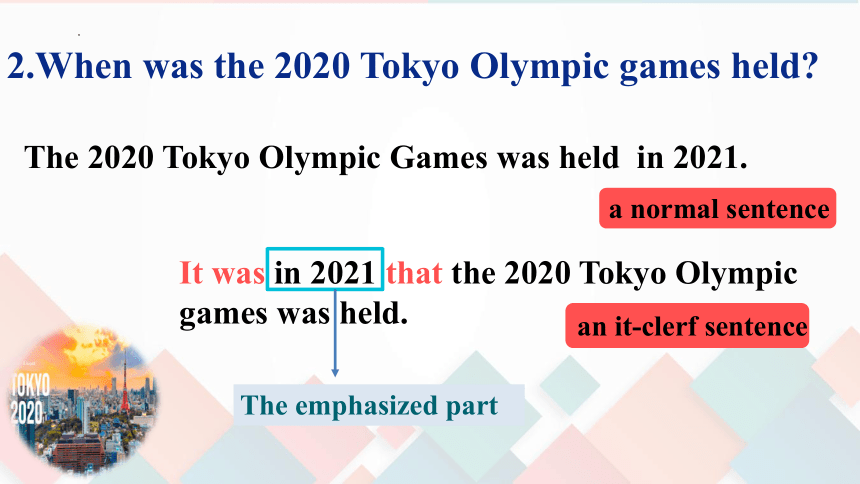
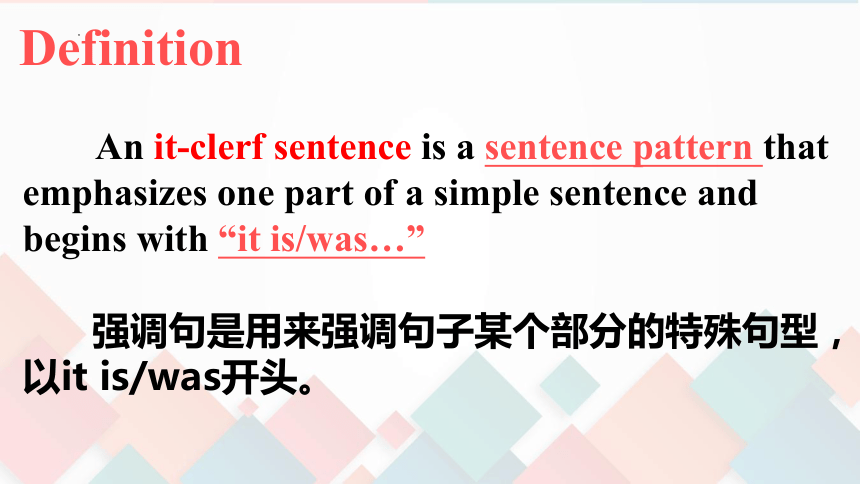
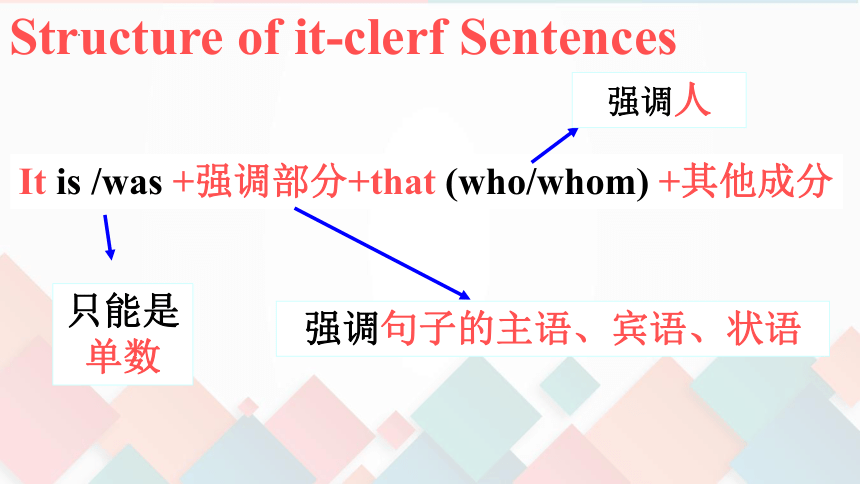
文档简介
(共16张PPT)
高中英语it 强调句
结构及用法
It------ clerf Sentence
Content:
Introduction of It-clerf Sentences
Lead-in:
Beethoven(贝多芬) met Haydn in 1791 but was not impressed by him. However, it was Haydn who encouraged Beethoven to move to Vienna.
--Book2 Module3
Who encouraged Beethoven to move to Vienna
Answer the question below.
1.Who encouraged Beethoven to move to Vienna
Haydn encouraged Beethoven to move to Vienna.
a normal sentence
It was Haydn who encouraged Beethoven to move to Vienna.
an it-clerf sentence
The emphasized part
2.When was the 2020 Tokyo Olympic games held
The 2020 Tokyo Olympic Games was held in 2021.
It was in 2021 that the 2020 Tokyo Olympic games was held.
a normal sentence
an it-clerf sentence
The emphasized part
An it-clerf sentence is a sentence pattern that emphasizes one part of a simple sentence and begins with “it is/was…”
强调句是用来强调句子某个部分的特殊句型,以it is/was开头。
Definition
It is /was +强调部分+that (who/whom) +其他成分
强调句子的主语、宾语、状语
强调人
只能是
单数
Structure of it-clerf Sentences
当我们要强调句子的某一部分(一般是主语,宾语,状语)时,可使用it强调句结构。
被强调的成分可以是句子的主语、宾语和状语,但不能是谓语
强调部分是人时,用who或that;
强调部分是其他成分时,用that
He met an old friend in the park yesterday.
主语
谓语
宾语
状语
以He met an old friend in the park yesterday.为例:
It was he who/that met an old friend in the park yesterday.
2)It was an old friend that/who he met in the park yesterday.
强调主语
强调宾语
3)It was in the park that he met an old friend yesterday.
强调地点状语
4)It was yesterday that he met an old friend in he park.
强调时间状语
Practice
Tom bought a cup from a store yesterday.
①强调主语Tom:
It was Tom who/that bought a cup from a store yesterday.
②强调宾语 a cup
It was a cup that Tom bought from a store yesterday.
Practice
Tom bought a cup from a store yesterday.
③强调地点状语from a store:
It was from a store that Tom bought a cup yesterday.
④强调时间状语yesterday:
It was yesterday that Tom bought a cup from a store.
当被强调部分指人时,用that/who (做宾语时可用whom);指物或既有人又有物时只用that;
It was Tom I met last week.
It is a new book his brother wants to buy.
who/that/ whom
that
tips
Exercise
1. It is in this street I bought the cup.
A . where B. that C.which D. from which
2. It was him I happened to meet.
A. which B. whom C. who D. what
Thank you for your listening
高中英语it 强调句
结构及用法
It------ clerf Sentence
Content:
Introduction of It-clerf Sentences
Lead-in:
Beethoven(贝多芬) met Haydn in 1791 but was not impressed by him. However, it was Haydn who encouraged Beethoven to move to Vienna.
--Book2 Module3
Who encouraged Beethoven to move to Vienna
Answer the question below.
1.Who encouraged Beethoven to move to Vienna
Haydn encouraged Beethoven to move to Vienna.
a normal sentence
It was Haydn who encouraged Beethoven to move to Vienna.
an it-clerf sentence
The emphasized part
2.When was the 2020 Tokyo Olympic games held
The 2020 Tokyo Olympic Games was held in 2021.
It was in 2021 that the 2020 Tokyo Olympic games was held.
a normal sentence
an it-clerf sentence
The emphasized part
An it-clerf sentence is a sentence pattern that emphasizes one part of a simple sentence and begins with “it is/was…”
强调句是用来强调句子某个部分的特殊句型,以it is/was开头。
Definition
It is /was +强调部分+that (who/whom) +其他成分
强调句子的主语、宾语、状语
强调人
只能是
单数
Structure of it-clerf Sentences
当我们要强调句子的某一部分(一般是主语,宾语,状语)时,可使用it强调句结构。
被强调的成分可以是句子的主语、宾语和状语,但不能是谓语
强调部分是人时,用who或that;
强调部分是其他成分时,用that
He met an old friend in the park yesterday.
主语
谓语
宾语
状语
以He met an old friend in the park yesterday.为例:
It was he who/that met an old friend in the park yesterday.
2)It was an old friend that/who he met in the park yesterday.
强调主语
强调宾语
3)It was in the park that he met an old friend yesterday.
强调地点状语
4)It was yesterday that he met an old friend in he park.
强调时间状语
Practice
Tom bought a cup from a store yesterday.
①强调主语Tom:
It was Tom who/that bought a cup from a store yesterday.
②强调宾语 a cup
It was a cup that Tom bought from a store yesterday.
Practice
Tom bought a cup from a store yesterday.
③强调地点状语from a store:
It was from a store that Tom bought a cup yesterday.
④强调时间状语yesterday:
It was yesterday that Tom bought a cup from a store.
当被强调部分指人时,用that/who (做宾语时可用whom);指物或既有人又有物时只用that;
It was Tom I met last week.
It is a new book his brother wants to buy.
who/that/ whom
that
tips
Exercise
1. It is in this street I bought the cup.
A . where B. that C.which D. from which
2. It was him I happened to meet.
A. which B. whom C. who D. what
Thank you for your listening
